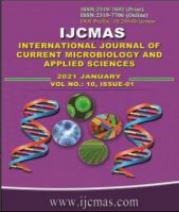


 National Academy of Agricultural Sciences (NAAS)
National Academy of Agricultural Sciences (NAAS)

|
PRINT ISSN : 2319-7692
Online ISSN : 2319-7706 Issues : 12 per year Publisher : Excellent Publishers Email : editorijcmas@gmail.com / submit@ijcmas.com Editor-in-chief: Dr.M.Prakash Index Copernicus ICV 2018: 95.39 NAAS RATING 2020: 5.38 |
Rice (Oryza sativa L.) is one among the foremost important staple food crops globally. In Asia, more than two billion people are getting 60-70 per cent of their energy requirement from rice and its derived products. In India, rice occupies an area of 43.79 million ha with an average production of 112.91 million tones and productivity of 2.58 tonnes/ha. Demand for rice is growing every year and it is estimated that in 2025 AD, the requirement would be 140 million tonnes. To accomplish this objective, the profitability of rice must be brought to the level of 3.3 tons/ha (Anjani et al., 2014). Food security depends on the power to extend production with decreasing availability of water to grow crops. Rice is one of the greatest water user among cereal crops, consuming about 80% of the total irrigated fresh water resources in Asia. To produce 1 kg of grain, farmers have to supply 3–5 times more water in rice fields than other cereals (Kumar et al., 2013). Quickly exhausting water resources threaten the sustainability of the irrigated rice and subsequently the food security and vocation of rice producers and purchasers. In Asia, 17 million hectare (Mha) of flooded rice areas may encounter "physical water scarcity" and 22 Mha may experience "economic water scarcity" by 2025. Key technological interventions which could alter or rectify the utilization of freshwater in agriculture are the need of the hour. In this context, the scientific interventions on water management involving direct seeded rice (DSR), system of rice intensification (SRI), alternate wetting and drying (AWD), furrow irrigated raised bed planting systems (FIRB) and other inclusive technological practices could enforce appropriate irrigation schedules. The potentials for water savings in rice production appear to be very large, however there is need to convince farmers to use less water without compromising land productivity.
 |
 |
 |
 |
 |